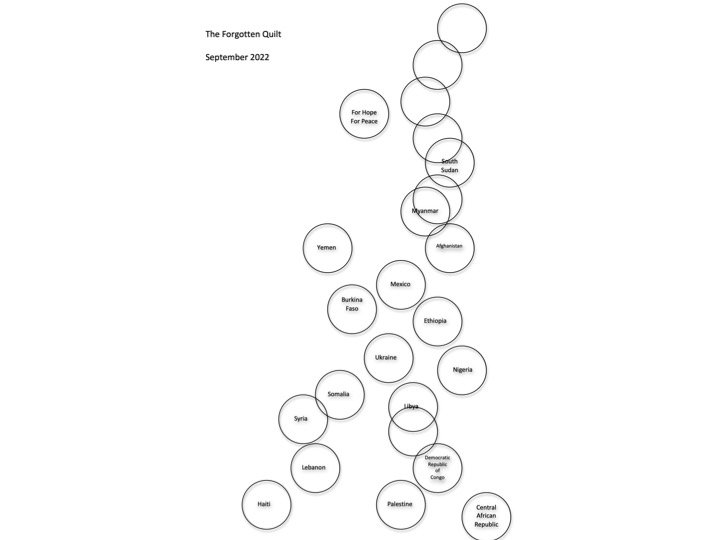The Forgotten Image:Ray Gumbley
2022 The Forgotten 200 x 92 cms. textile.
Customarily made by women, a quilt signifies warmth, comfort and security. Here I have drawn on a mixture of traditional techniques such as patchwork, quilting and appliqué rather than a single, conventional method. Both machine and hand stitching were used. Using a six-sided ‘flower’ design with a hexagonal centre, each segment represents the colours of a country in conflict with several pure white segments. These uncoloured pieces could be seen to stand in for my hopes and dreams for peace and are placed high up on the quilt whilst the other pieces tumble down to the bottom. However, they could also be viewed as wars yet to happen. No priority is given to any conflict represented by the colour segment by its position on the quilt. The arrangement is random. The jagged edge suggests the unending nature of many disputes and the constant flare-ups between countries. As an example, only this morning, September 13th, 2022, there were reports of cross-border shooting between Armenia and Azerbaijan.
Each segment represents the colours of a country where there is conflict at the time of making this work
The fabric was collected from charity shops. A best shirt - for a wedding? A sixties short red raincoat, gold from a theatre costume. Drawing strangers together through their cast-off clothes gathers more than just the immediate present. It is a social and cultural history. Clothing from its natural and man-made materials to the garment making itself through to its eventual end of life is a worldwide activity that is often related to women.
I wanted this work to be representative of its time through its thriftiness and, therefore, its sustainability in these times of economic hardships and environmental awareness. I wanted to draw attention to problems whose root cause was often created by the West and so-called first world. But, overwhelmingly, I wanted to bring to the forefront, the impact of war on women who often have no say.
The Forgotten Quilt thinks about the disproportional impact of war on women. Khanyi Mlaba writes in the Global Citizen (https://www.globalcitizen.org/), March 23, 2022: ‘War, conflict, and crises introduce women and girls to a very real fear: that their safety and human rights will be the last priority amid the violence…….Simply because of their gender, women and girls caught in the middle of war experience sexual violence, physical and verbal abuse, and barriers in accessing resources and having their human rights met; this is of course all on top of being directly exposed to conflict on the front lines and facing life-threatening conditions’.
War can be invasion by another country, civil war, terrorist insurgency, localised conflict, drugs wars but the effect is usually the same.
Again, Mlaba writes: ‘The biggest risk they face is gender-based violence. Women and girls are exposed to unprecedented rates of sexual violence, abuse, and torture in war conditions.
Conflict enforces the objectification of women and girls, as they are often seen as weapons of war, being used by perpetrators of violence to assert control.
More than half of the world’s conflict-related refugee population is made up of women and children’. (https://www.globalcitizen.org/)
The Forgotten quilt focuses on seventeen countries where conflict is currently taking place. These are: Afghanistan, Burkina Faso, Central African Republic, Democratic Republic of Congo, Ethiopia, Haiti, Iraq, Lebanon, Libya, Mexico, Myanmar, Nigeria, Palestine, Somalia, South Sudan, Syria, Ukraine, Yemen. There are others. For instance, in Ethiopia, conflict has drawn in border areas of Eritrea and the choices that I made for this work were difficult. These seventeen appeared in more than one list from websites -
https://www.globalcitizen.org/
https://www.worldpoliticsreview.com
I have tried to be unbiased and concentrate on women in war of either side of a dispute. For example, how are the women of Russia, whatever their beliefs, faring particularly in the areas bordering Ukraine? Whilst the drugs war in Mexico may not seem as important as some conflicts, many thousands of people, many male, have been killed often leaving families without means of support.


